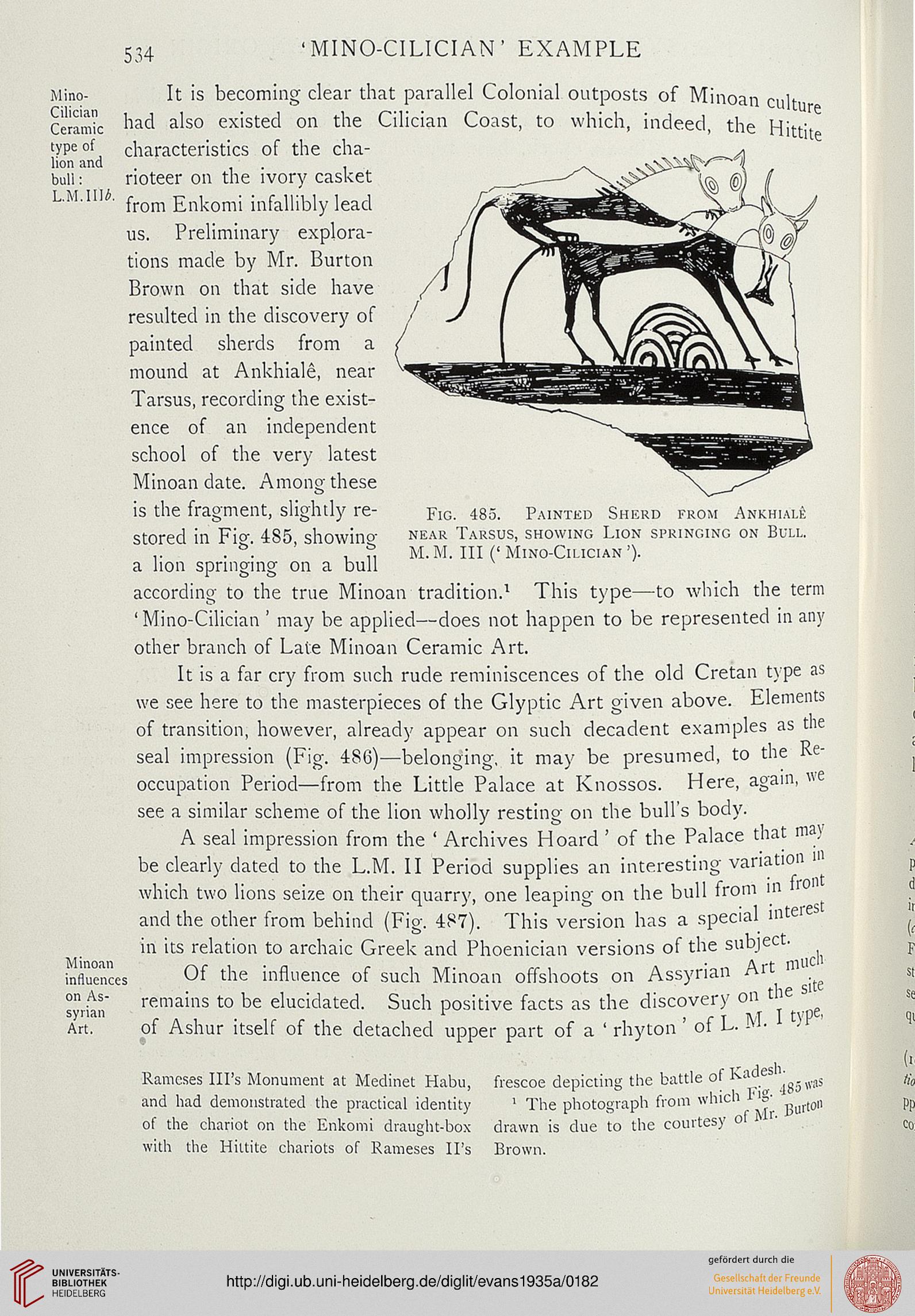Mino-
Cilician
Ceramic
type of
lion and
bull:
L.M.III*.
534 'MINO-CILICIAN' EXAMPLE
It is becoming clear that parallel Colonial outposts of Minoan <
Hittite
culture
had also existed on the Cilician Coast, to which, indeed, the Hi
characteristics of the cha-
rioteer on the ivory casket
from Enkomi infallibly lead
us. Preliminary explora-
tions made by Mr. Burton
Brown on that side have
resulted in the discovery of
painted sherds from a
mound at Ankhiale, near
Tarsus, recording the exist-
ence of an independent
school of the very latest
Minoan date. Among these
is the fragment, slightly re-
stored in Fig. 485, showing
a lion springing on a bull
Fig. 485. Painted Sherd from Ankhiale
near Tarsus, showing Lion springing on Bull.
M. M. Ill (' Mino-Cilician ').
Minoan
influences
on As-
syrian
Art.
according to the true Minoan tradition.1 This type—to which the term
' Mino-Cilician ' may be applied—does not happen to be represented in any
other branch of Late Minoan Ceramic Art.
It is a far cry from such rude reminiscences of the old Cretan type as
we see here to the masterpieces of the Glyptic Art given above. Elements
of transition, however, already appear on such decadent examples as tlie
seal impression (Fig. 4S6)—belonging, it may be presumed, to the Ke-
occupation Period—from the Little Palace at Knossos. Here, again, we
see a similar scheme of the lion wholly resting on the bull's body.
A seal impression from the ' Archives Hoard ' of the Palace that may
be clearly dated to the L.M. II Period supplies an interesting variation in
which two lions seize on their quarry, one leaping on the bull from in
and the other from behind (Fig. 487). This version has a special interes
in its relation to archaic Greek and Phoenician versions of the subjec .
Of the influence of such Minoan offshoots on Assyrian Art i'"
ich
the site
remains to be elucidated. Such positive facts as the discovery on
i c t ivT I typci
of Ashur itself of the detached upper part of a ' rhyton of U -VJ-
Ramcses Ill's Monument at Medinet Habu, frescoe depicting the battle of Kades • ^
which I'tg-
and had demonstrated the practical identity
of the chariot on the Enkomi draught-box
with the Hittite chariots of Rameses II's
' The photograph from w..—- --; Bnrt0„
drawn is due to the courtesy ot » •
Brown.
Cilician
Ceramic
type of
lion and
bull:
L.M.III*.
534 'MINO-CILICIAN' EXAMPLE
It is becoming clear that parallel Colonial outposts of Minoan <
Hittite
culture
had also existed on the Cilician Coast, to which, indeed, the Hi
characteristics of the cha-
rioteer on the ivory casket
from Enkomi infallibly lead
us. Preliminary explora-
tions made by Mr. Burton
Brown on that side have
resulted in the discovery of
painted sherds from a
mound at Ankhiale, near
Tarsus, recording the exist-
ence of an independent
school of the very latest
Minoan date. Among these
is the fragment, slightly re-
stored in Fig. 485, showing
a lion springing on a bull
Fig. 485. Painted Sherd from Ankhiale
near Tarsus, showing Lion springing on Bull.
M. M. Ill (' Mino-Cilician ').
Minoan
influences
on As-
syrian
Art.
according to the true Minoan tradition.1 This type—to which the term
' Mino-Cilician ' may be applied—does not happen to be represented in any
other branch of Late Minoan Ceramic Art.
It is a far cry from such rude reminiscences of the old Cretan type as
we see here to the masterpieces of the Glyptic Art given above. Elements
of transition, however, already appear on such decadent examples as tlie
seal impression (Fig. 4S6)—belonging, it may be presumed, to the Ke-
occupation Period—from the Little Palace at Knossos. Here, again, we
see a similar scheme of the lion wholly resting on the bull's body.
A seal impression from the ' Archives Hoard ' of the Palace that may
be clearly dated to the L.M. II Period supplies an interesting variation in
which two lions seize on their quarry, one leaping on the bull from in
and the other from behind (Fig. 487). This version has a special interes
in its relation to archaic Greek and Phoenician versions of the subjec .
Of the influence of such Minoan offshoots on Assyrian Art i'"
ich
the site
remains to be elucidated. Such positive facts as the discovery on
i c t ivT I typci
of Ashur itself of the detached upper part of a ' rhyton of U -VJ-
Ramcses Ill's Monument at Medinet Habu, frescoe depicting the battle of Kades • ^
which I'tg-
and had demonstrated the practical identity
of the chariot on the Enkomi draught-box
with the Hittite chariots of Rameses II's
' The photograph from w..—- --; Bnrt0„
drawn is due to the courtesy ot » •
Brown.





